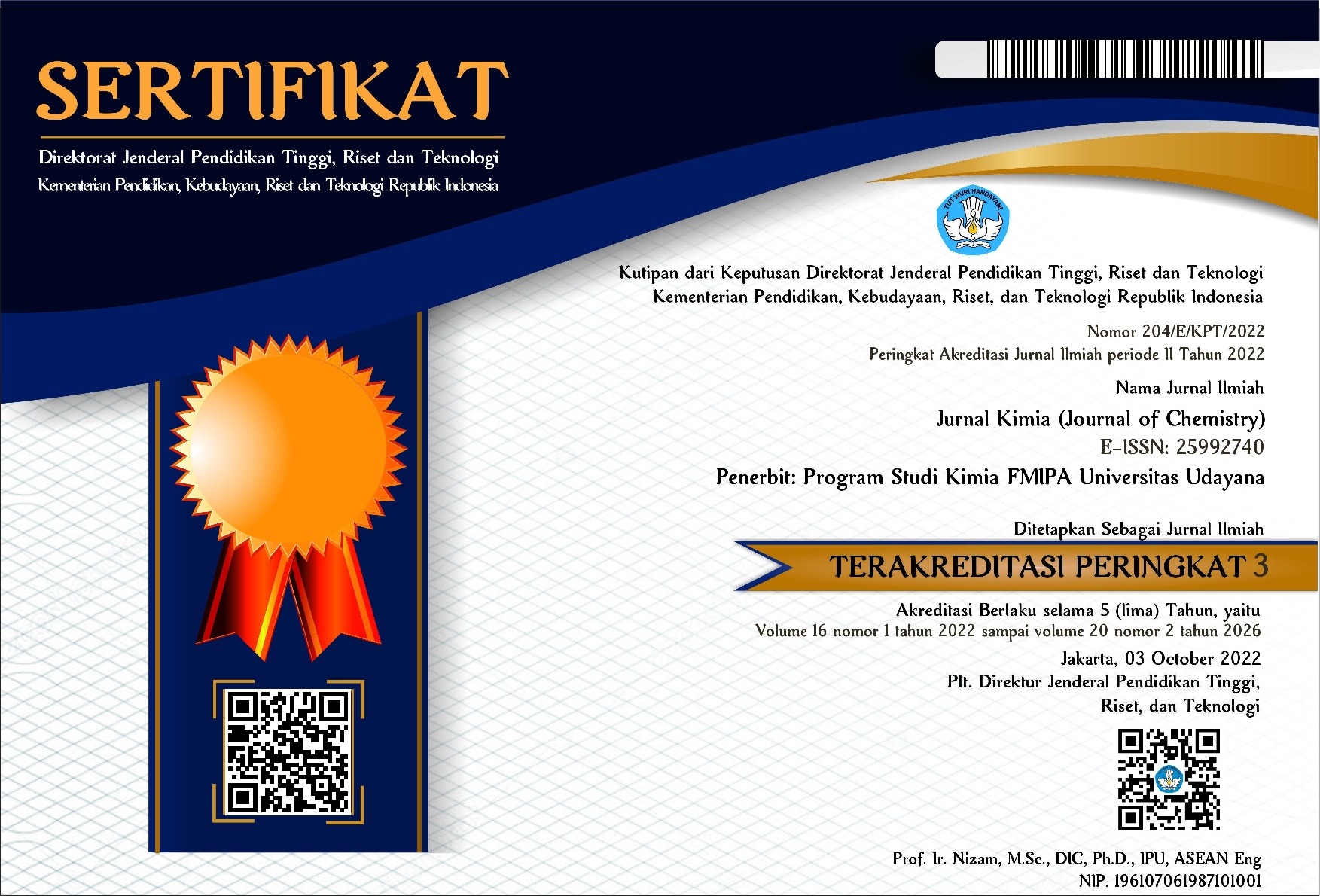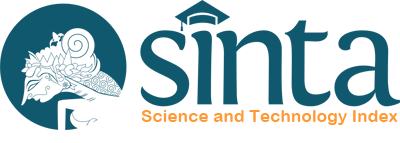PEMULIHAN UNSUR BERHARGA (TITANIUM OKSIDA/TiO2) DARI LIMBAH PERTAMBANGAN BAUKSIT (RED MUD) MENGGUNAKAN METODE ACID LEACHINGg
Abstract
Penelitian ini dilatarbelakangi oleh tingginya volume limbah red mud (RM) dari industri pengolahan bauksit yang berpotensi mencemari lingkungan. RM mengandung logam berharga seperti Titanium Oksida (TiO2), yang dapat dimanfaatkan untuk mengurangi limbah dan mendukung ekonomi sirkular. Penelitian ini bertujuan memulihkan TiO2 dari RM menggunakan metode acid leaching. Prosedur dimulai dengan pengeringan sampel, penghalusan, dan ekstraksi menggunakan larutan asam hidrobromida (HBr). Variasi konsentrasi asam, suhu, dan durasi ekstraksi diterapkan untuk mengidentifikasi kondisi optimal. Analisis XRF digunakan untuk mengukur komposisi kimia RM, sementara persentase pemulihan titanium dievaluasi pada berbagai parameter. Hasil menunjukkan bahwa suhu 75°C dan konsentrasi HBr 8,82 mol/L dengan waktu reaksi 2 jam menghasilkan pemulihan TiO2 terbaik, mencapai 69,54%. Namun, durasi reaksi yang lebih lama mengurangi efisiensi karena pembentukan produk samping. Penelitian ini menunjukkan bahwa kondisi ekstraksi yang terkontrol dapat meningkatkan efisiensi pemulihan logam berharga dari RM. Metode ini tidak hanya menawarkan solusi untuk mengurangi limbah, tetapi juga memberikan manfaat ekonomi melalui pemanfaatan kembali limbah pertambangan bauksit.
Kata kunci:
titanium oksida, bauksit, red mud, acid leaching, asam hidrobromida
ABSTRACT
This study addresses the high volume of red mud (RM) waste generated by the bauxite processing industry, which poses significant environmental risks. RM contains valuable metals such as Titanium Dioxide (TiO2), which can be utilized to reduce waste and support the circular economy. This research aims to recover TiO2 from RM using the acid leaching method. The procedure begins with sample drying, grinding, and extraction using hydrobromic acid (HBr) solution. Variations in acid concentration, temperature, and extraction duration were applied to identify optimal conditions. XRF analysis was used to measure RM's chemical composition, while titanium recovery percentages were evaluated under different parameters. Results showed that a temperature of 75°C, HBr concentration of 8.82 mol/L, and a reaction time of 2 hours produced the best TiO2 recovery, reaching 69.54%. However, longer reaction durations reduced efficiency due to the formation of by-products. This study demonstrates that controlled extraction conditions can enhance the recovery efficiency of valuable metals from RM. The method not only offers a solution for reducing waste but also provides economic benefits through the reuse of metal from tailings.
Keywords:
titanium oxide, bauxite, red mud, acid leaching, hydrobromic acid
Downloads
References
Bonomi, C., Alexandri, A., Vind, J., Panagiotopoulou, A., Tsakiridis, P., Panias, D. 2018. Scandium and titanium recovery from bauxite residue by direct leaching with a Brønsted acidic ionic liquid. Metals, 8(10), 834.
Deep, A., Malik, P., Gupta, B. 2001. Extraction and separation of Ti (IV) using thiophosphinic acids and its recovery from ilmenite and red mud. Separation Science and Technology, 36(4), 671-685.
Guohai, Z., Keqin, W., Hao, W. 2012. Study on recovering titanium dioxide from red mud vitriol leached residue. Nonferrous Metals (Extractive Metallurgy), 7, 23-26.
Huang, Y., Chai, W., Han, G., Wang, W., Yang, S., Liu, J. 2016. A perspective of stepwise utilisation of Bayer red mud: Step two—Extracting and recovering Ti from Ti-enriched tailing with acid leaching and precipitate flotation. Journal of Hazardous Materials, 307, 318-327.
Kasliwal, P., Sai, P. 1999. Enrichment of titanium dioxide in red mud: a kinetic study. Hydrometallurgy, 53(1), 73-87.
Li, S., Pan, J., Zhu, D., Guo, Z., Shi, Y., Dong, T., Lu, S., Tian, H. 2021. A new route for separation and recovery of Fe, Al and Ti from red mud. Resources, Conservation and Recycling, 168, 105314.
Pan, X., Wu, H., Lv, Z., Yu, H., Tu, G. 2023. Recovery of valuable metals from red mud: A comprehensive review. Science of The Total Environment, 166686.
Shim, W.G., Nah, J.W., Jung, H.-Y., Park, Y.-K., Jung, S.C., Kim, S.C. 2018. Recycling of red mud as a catalyst for complete oxidation of benzene. Journal of Industrial and Engineering Chemistry, 60, 259-267.
Tang, W., Wang, Z., Donne, S., Forghani, M., Liu, Y. 2019. Influence of red mud on mechanical and durability performance of self-compacting concrete. Journal of hazardous materials, 379, 120802.
Wang, S., Jin, H., Deng, Y., Xiao, Y. 2021. Comprehensive utilization status of red mud in China: A critical review. Journal of Cleaner Production, 289, 125136.
Xu, Z.-M., Zhang, Y.-X., Wang, L., Liu, C.-G., Sun, W.-M., Wang, Y.-F., Long, S.-X., He, X.-T., Lin, Z., Liang, J.-L. 2022. Rhizobacteria communities reshaped by red mud based passivators is vital for reducing soil Cd accumulation in edible amaranth. Science of the Total Environment, 826, 154002.
Zhu, X., Li, W., Guan, X. 2015. An active dealkalization of red mud with roasting and water leaching. Journal of hazardous materials, 286, 85-91

This work is licensed under a Creative Commons Attribution 4.0 International License





